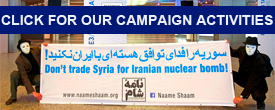 An article by Torie Rose DeGhett, Vice News, October 8, 2015, quoting Naame Shaam’s Campaigns Director Fouad Hamdan:
An article by Torie Rose DeGhett, Vice News, October 8, 2015, quoting Naame Shaam’s Campaigns Director Fouad Hamdan:
“Hamdan represents another camp; when asked if Iran is already over its head inside the civil war, his answer is, “yes, absolutely.”
“Specifically referencing Hezbollah’s involvement, Hamdan believes that, as an invading force, they “are not going to survive it. [They] will not get out in one piece. It is a Vietnam…. They think they can get away with it.” Despite early optimism for swift victory, he notes, two years later, they remain inside Syria.”
———
“Is Syria about to become Iran’s Vietnam?”
By Torie Rose DeGhett, Vice News, October 8, 2015, link
Iran has invested heavily in Syria’s civil war. Having already spilled much blood and spent much treasure to shore up President Bashar al-Assad against opposition forces, Tehran appears to be doubling down with yet more commitments of resources and manpower. But will Iran’s efforts make a difference? Assad’s side is now faltering, even publicly admitting this summer that it faces a severe manpower shortage thanks to death and defection.
Because of Iran’s ever-deepening involvement in the fighting, analysts have speculated about the possibility that Syria could be Iran’s Vietnam. The parallel may be imperfect, but the comparison has become political shorthand for a more basic question: has Iran stuck itself in a quagmire?
A strict, direct comparison between Iran’s involvement in Syria and Cold War America’s entanglement in Vietnam is difficult for a few reasons. Fragmentation is built into the nature of the multi-sided Syrian conflict, during which the Carter Center estimates 7,000 rebel groups have formed. Members of the opposition have joined together in umbrella groups –– some Islamist like the Army of the Conquest or the Saudi-backed Army of Islam, others secular and US-backed like the Southern Front. The Kurds control much of the northern border. They primarily battle the Islamic State, seated in Raqqa, which controls territory that cuts a diagonal swath across Syria. Assad and his shadowy array of supporters grip tightly onto control in the west.
Additionally, the structuring of the Iranian presence in Syria is much different than the US intervention in Vietnam — there is no major deployment of conventional military forces. Rather, Iran is primarily relying on militias and proxy forces to aid the Syrian government’s battle for control, rather than the US approach which ultimately involved large numbers of conventional military forces directly engaged in combat.
This preference for acting by proxy makes the Iranian decision to boost the number of uniformed troops on the ground a bit surprising. According to two unnamed Lebanese sources, Iran may have just deployed hundreds of more troops into this fragmented territory with its patchwork of frontlines. These troops, however, would not be regular Iranian military, notes Dina Esfandiary, a research associate at King’s College London.
“When they say Iran is sending in ground troops, they’re presuming it’s the Iranian army [but]… Iran has not sent its army abroad since the Iran-Iraq war and it has certainly not done so today in Syria,” she says. These forces, if they are present, will be members of the Iranian Revolutionary Guard Corps (IRGC).
Fouad Hamdan, the campaign director for Naame Shaam, an advocacy group aimed at highlighting the consequences of Iran’s presence in Syria, says his organization has seen reports of a new influx of IRGC, but cannot confirm it.
However, the most important difference is the reason that Iran is willing to stick up for Syria at such cost. Iran is not getting sucked into a faraway, postcolonial morass of someone else’s creation. Rather, it is voluntarily involving itself on behalf of a longstanding regional ally.
Syria, along with Iran and Hezbollah, is a key member of the Axis of Resistance that aspires to counter Israel and the West.
Iran’s close ties with Syria date to 1979, when Syria was the first Arab country to recognize the revolutionary government with a congratulatory message to the Ayatollah. Since Hafez al-Assad’s post-coup overtures, the Iran-Syria relationship has remained strong. They redoubled their commitments to one another after the US invasion of Iraq in 2003, signing a mutual defense pact in 2005.
The relationship among the central triad of the Axis of Resistance became especially critical in 2006, at the end of a 34-day war between Israel and Hezbollah. Syria helped Iran resupply Hezbollah in defiance of an international arms embargo, returning their arsenal to pre-war capacity in short order.
Syria has, for the last decade, been Iran’s primary position of strength in the region, acting as a channel for military and financial support to Hezbollah and harboring militant training camps.
Syria is geopolitically crucial for Hezbollah’s operations and capacity, and this is one of the major reasons why Hezbollah and Iran are coming to the aid of the Assad regime. Syria has been an enormous resource for the group, and for Iranian influence in the Levant.
Now, Iran and Hezbollah have risen to back their ally, touting Syria’s importance to the Axis. Hezbollah chief Hassan Nasrallah, in a 2013 speech explaining Hezbollah’s intervention to prevent the fall of the Assad regime, described Syria as “the backbone of the resistance,” referring to its pivotal role in supporting the organization. “We will not sit with our hands crossed,” he added.
Iran and Hezbollah helped the Syrian government incorporate the gangs known as the shabiha into the more organized and respectably-titled National Defense Forces in 2013. This new armed entity, trained by the IRGC and Hezbollah, is modeled on Iran’s Basij militia. And although Hezbollah has been deliberately deceptive about the scale of their direct military commitment, analysts peg the number of the group’s fighters active in Syria at between 6000 and 8000.
So maybe the Vietnam comparison doesn’t rest solely with Iran: there’s growing evidence that Hezbollah is feeling the cost of its participation as well, which has increased throughout 2015. The group is a powerful military force and continues to enjoy support inside Lebanon, but there are murmurs of dissent and skepticism as the war drags on. The group’s losses in the civil war are not known, but estimates over the summer put the toll at 700 to 1,000. To put this in perspective, Hezbollah lost a total of 1,248 fighters over the course of its war with Israel between 1985 and 2000. The group appears to be reaching, or possibly to have already surpassed, that tally in just two years of open combat inside Syria.
Sheikh Sobhi Tufayli, a Hezbollah founder who was expelled from the group in 1998, told the Christian Science Monitor that Nasrallah has “started a war with our neighbors that we will feel for generations.”
Of course, Syria isn’t the only country where the Iranian military is involved. The situation in Iraq affects Iran’s commitments and capacity on the ground in Syria, and the status of Iranian proxy militias has waxed and waned along with events next door. Following the fall of Mosul to the Islamic State in summer of 2014, Iraqi militias redirected from fronts in Syria to fronts in Iraq, requiring Hezbollah to step up to compensate. As Esfandiary explains, “if [Iraq is] calmer, then that frees up some of Iran’s resources to focus a little bit more on Syria, which is of course the second priority.”
Online activity this summer and fall indicates a strengthening presence of Iraqi fighters in Syria and a more active pace of recruitment by groups like Iranian-backed Kataib al Imam Ali (KIA), a group formed from various Shia splinter militias. Mid-September reports that Shia militias were active near Latakia also hint at the potential for Russian collaboration, or at least coordination, with Iranian-backed paramilitary forces.
Also fighting to support the Assad regime and stave off rebel advances are thousands of Afghan fighters in the Tehran-controlled Fatimiyoun Brigade. These are recruits gathered up, often coercively, by the IRGC from Iran’s impoverished and persecuted Afghan Hazara community. Like the Iraqi militias, the Fatimiyoun Brigade has increased its pace, becoming more noticeably active in late 2014 and early 2015 with their participation in regime fighting near Aleppo and an offensive alongside IRGC and Hezbollah forces in Dera’a in February.
All of this represents significant Iranian investment in the conflict, and the potential scope of Tehran’s dedication to helping the Assad government survive. It is hard to monitor or quantify the full extent of Iran’s commitments. Whether or not this situation becomes untenable for Iran is a question of how much distance they have granted themselves in making such vast use of proxy agents and militias stocked with Shia recruits.
When it comes to the direction of the conflict in Syria and what should be done next, “there’s quite a bit of divergence in the Iranian government,” says Esfandiary. “A lot of the hardliners, including the IRGC, are very much in favor of ensuring that Assad doesn’t go anywhere. But then you talk to the Rouhani government and [Foreign Minister Javad] Zarif and they say [they] need to resolve Syria because the war hasn’t gone well.”
Ultimately, there are differences of opinion about whether or not Iran has signed itself up for an inextricable intervention.
“Yes, they’ve invested a lot and it’s a costly investment if it doesn’t work out well,” says Esfandiary, “but I think Iran is pretty pragmatic. So if it feels like it’s really cornered an it absolutely has to get out of Syria, then it will find a way do that and save face at the same time.”
Hamdan represents another camp; when asked if Iran is already over its head inside the civil war, his answer is, “yes, absolutely.”
Specifically referencing Hezbollah’s involvement, Hamdan believes that, as an invading force, they “are not going to survive it. [They] will not get out in one piece. It is a Vietnam…. They think they can get away with it.” Despite early optimism for swift victory, he notes, two years later, they remain inside Syria.
In Syria, Iran runs the risk of losing public face as a patron of its Shia allies. Another risk is the loss of its critical Levantine foothold and means of bolstering Hezbollah. The stakes for Iran are high, and the path forward costly and unclear. With the Syrian conflict as bloody, byzantine and intractable as it is, what kind of victory can Iran aspire to?
 English
English  فارسی
فارسی  العربية
العربية 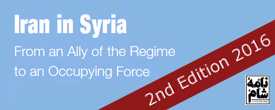
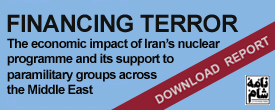
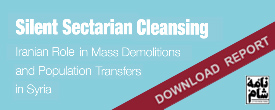
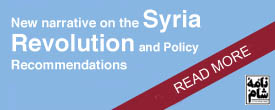

 On Twitter
On Twitter